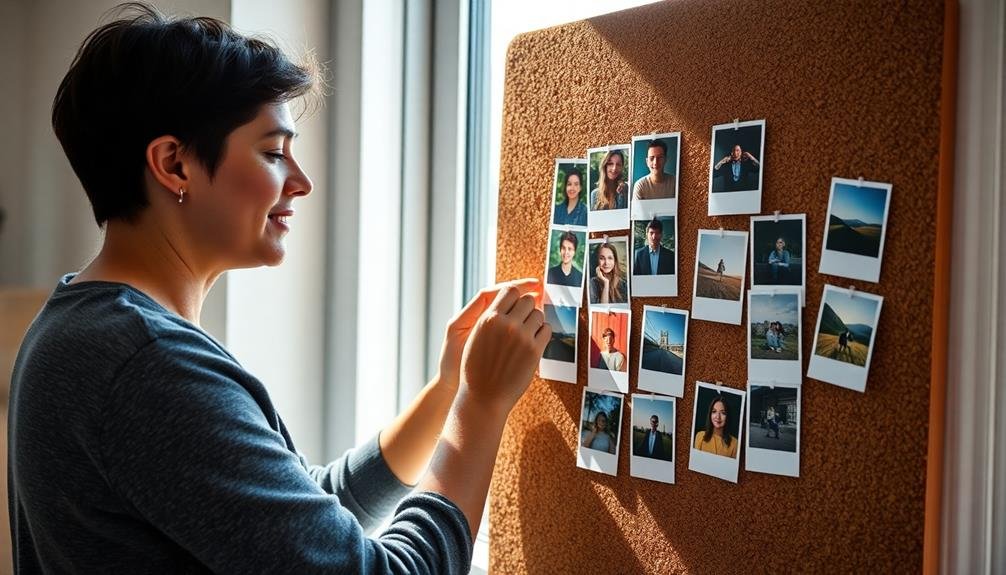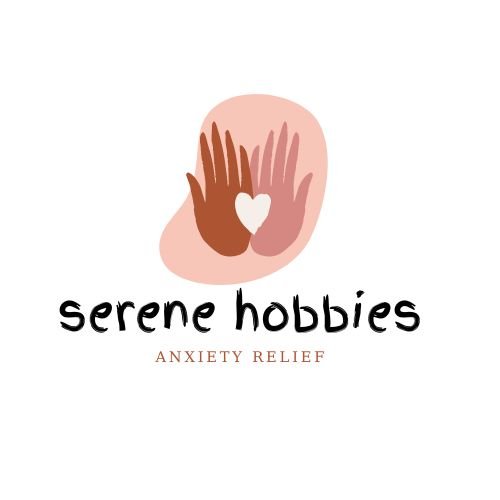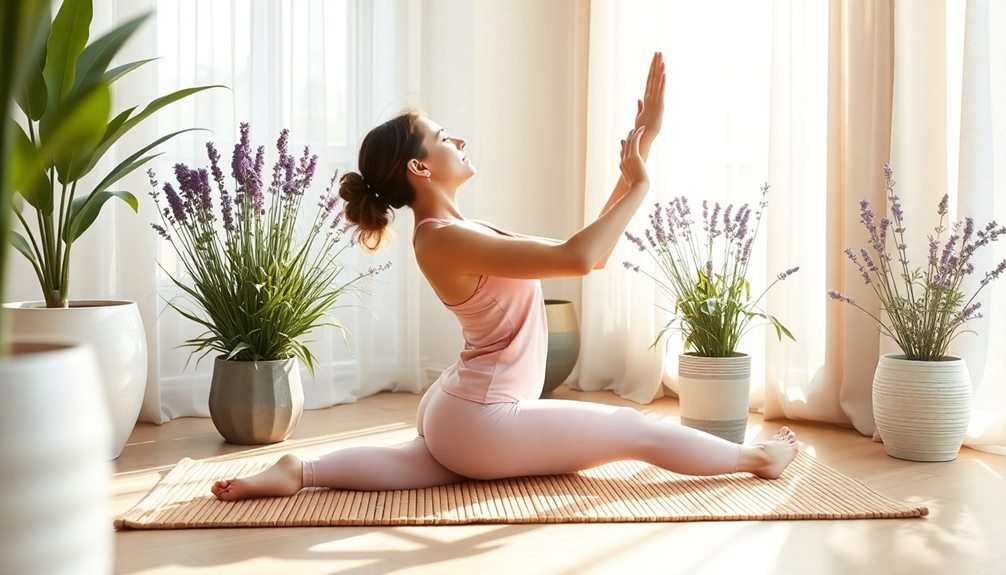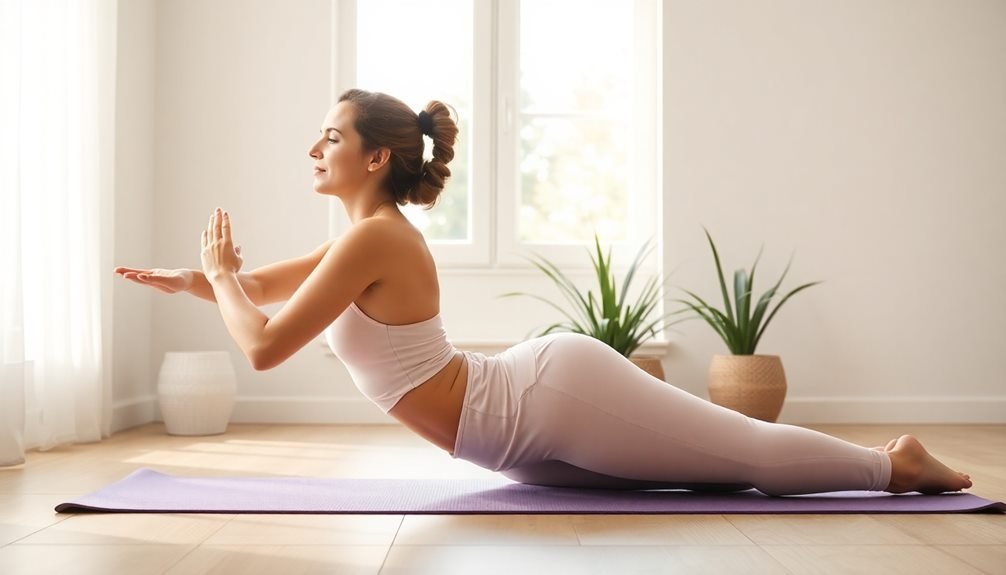Photo storytelling exercises can greatly reduce your anxiety by engaging multiple aspects of your mind and emotions. You'll express yourself visually, practice mindfulness through careful observation, and gain control over your narrative. These activities shift your focus away from anxious thoughts, providing a creative distraction. As you craft your visual story, you'll discover new insights about yourself and your experiences. Sharing these stories can foster social connections and mutual understanding. The process of curating and arranging images allows you to externalize your feelings and gain fresh perspectives. Exploring this creative approach might reveal even more benefits for your mental well-being.
Visual Expression of Emotions

Three powerful ways to visually express emotions through photography include capturing facial expressions, using color symbolism, and framing with body language.
When you focus on facial expressions, you'll convey a range of emotions from joy to sorrow. Look for genuine moments and subtle nuances in your subject's face to tell a compelling story.
Color symbolism can evoke specific moods and feelings in your photos. Warm tones like red and orange might represent passion or energy, while cool blues and greens can suggest calmness or melancholy.
Experiment with different color palettes to match the emotional tone of your narrative.
Body language is a vital element in visual storytelling. The way you frame your subject's posture, gestures, and positioning can communicate volumes about their emotional state.
A hunched figure might convey despair, while an open, expansive pose could suggest confidence or joy.
Mindful Observation Through Photography
Photography can serve as a powerful tool for mindful observation, helping you focus on the present moment and alleviate anxiety. When you're behind the camera, you're forced to slow down and really look at your surroundings. This act of careful observation can ground you in the here and now, pulling your attention away from anxious thoughts.
As you frame your shots, you'll start noticing details you might otherwise overlook. The play of light and shadow, the texture of surfaces, or the subtle color variations in nature can become fascinating subjects. This heightened awareness of your environment can be deeply calming and meditative.
Try setting yourself small challenges, like photographing different textures or finding interesting shapes in everyday objects. These exercises will keep you engaged and present, effectively distracting you from anxiety-inducing thoughts.
You'll also develop a new appreciation for the beauty in ordinary things.
Creating Narrative Control

You can take control of your anxiety narrative through photo storytelling.
By crafting personal visual stories, you're able to express and process your emotions in a tangible, manageable way.
As you direct the emotional flow of your visual narrative, you'll gain a sense of empowerment over your anxiety-related experiences.
Crafting Personal Visual Stories
Through crafting personal visual stories, you can gain a sense of narrative control over your anxiety. Begin by selecting images that resonate with your experiences and emotions. These can be photos you've taken or meaningful images you've collected. Arrange them in a sequence that tells your story, creating a visual narrative of your journey with anxiety.
As you craft your visual story, focus on key moments of strength, growth, and resilience. Include images that represent challenges you've overcome and coping strategies you've developed. This process allows you to externalize your experiences, giving you a fresh perspective on your anxiety.
Don't shy away from including difficult moments; acknowledging them can be empowering. Balance these with images that represent hope, support, and progress. As you curate and arrange your visual story, you're actively shaping your narrative, reinforcing your role as the author of your own experience.
This exercise helps you see patterns in your anxiety journey, identify triggers, and recognize your progress. By visually mapping your experiences, you create a tangible representation of your strength and resilience, reinforcing your ability to manage anxiety.
Directing Emotional Visual Flow
Building on the concept of crafting personal visual stories, directing emotional visual flow allows you to take even greater control of your anxiety narrative. By carefully selecting and arranging your images, you're creating a visual journey that guides viewers through your emotional landscape.
Start by identifying the key emotions you want to convey. Choose photos that represent these feelings, whether they're literal or metaphorical. Arrange them in a sequence that reflects your emotional progression, from anxiety to calm or from uncertainty to resolution.
Consider using color psychology to enhance the emotional impact. Cool blues and greens can evoke tranquility, while warm oranges and reds might represent anxiety or tension. Play with contrast and composition to draw attention to specific elements that are essential to your story.
Don't shy away from including images that represent challenging moments. These create tension and make the resolution more impactful.
As you arrange your photos, think about pacing. Intersperse intense images with calmer ones to create a rhythm that mirrors the ebb and flow of anxiety.
Distraction From Anxious Thoughts
Photo storytelling exercises can effectively shift your mental focus away from anxious thoughts.
As you engage in the creative process of crafting visual narratives, you'll activate different parts of your brain, pushing worry to the background.
This technique helps break rumination cycles by immersing you in a constructive activity that demands your attention and imagination.
Shifts Mental Focus
By engaging in photo storytelling exercises, you're able to shift your mental focus away from anxious thoughts. This redirection of attention is a powerful tool in managing anxiety. As you concentrate on selecting images, arranging them in a sequence, and crafting a narrative, your brain becomes occupied with creative tasks rather than dwelling on worries.
The process of photo storytelling demands your full attention, leaving little room for anxious rumination. You'll find yourself immersed in details like color schemes, composition, and the emotions evoked by each image. This intense focus on visual elements and storytelling naturally pushes anxiety-inducing thoughts to the background.
Moreover, as you develop your story, you're engaging in problem-solving and decision-making. These cognitive processes require active mental engagement, further diverting your mind from anxiety. You're not just passively observing; you're actively creating, which stimulates different neural pathways.
The act of shifting your focus through photo storytelling can help break the cycle of anxious thoughts, providing temporary relief and potentially offering long-term benefits in managing anxiety.
Engages Creative Processes
Through the lens of creativity, photo storytelling exercises offer a powerful distraction from anxious thoughts. As you engage in this process, you're activating different parts of your brain, shifting focus away from worry and towards imagination. You'll find yourself immersed in a world of visual storytelling, where your creative instincts take center stage.
The act of composing images and crafting narratives taps into your innate artistic abilities. You're no longer dwelling on anxious thoughts but instead exploring new perspectives and possibilities. This creative engagement can be broken down into several key components:
| Creative Process | Anxiety-Reducing Effect |
|---|---|
| Image Selection | Focuses attention |
| Narrative Design | Structures thoughts |
| Visual Editing | Encourages problem-solving |
| Story Sequencing | Promotes logical thinking |
| Sharing Results | Boosts self-expression |
Breaks Rumination Cycles
While engaging creative processes is valuable, the true power of photo storytelling lies in its ability to break rumination cycles. When you're caught in a loop of anxious thoughts, shifting your focus to visual storytelling can provide much-needed relief.
By immersing yourself in the task of selecting, arranging, and narrating photos, you're effectively redirecting your mental energy away from worry. This process interrupts the cycle of negative thinking by:
- Demanding your full attention and concentration
- Activating different parts of your brain
- Encouraging a more positive, reflective mindset
- Providing a sense of control over your narrative
- Creating distance from anxiety-inducing thoughts
As you craft your photo story, you're not just distracting yourself; you're actively reframing your experiences.
You're choosing which moments to highlight and how to present them, giving you agency over your personal narrative. This shift in perspective can be powerful in managing anxiety, as it helps you see beyond your immediate concerns and reconnect with the broader context of your life experiences.
Social Connection via Shared Stories

How can sharing photo stories help combat anxiety and foster social connections? When you share your visual narratives, you're opening a window into your world, inviting others to understand and empathize with your experiences. This act of vulnerability can lead to deeper, more meaningful relationships and a sense of belonging.
By sharing your photo stories, you're not only expressing yourself but also encouraging others to do the same. This reciprocal exchange creates a supportive environment where individuals can feel heard and understood. It's particularly beneficial for those struggling with anxiety, as it provides a safe space to communicate emotions that might be difficult to express verbally.
| Benefits | For You | For Others |
|---|---|---|
| Emotional | Catharsis | Empathy |
| Social | Connection | Understanding |
| Psychological | Self-awareness | Perspective |
| Communication | Self-expression | Active listening |
| Support | Feeling validated | Offering support |
The act of sharing photo stories can also help you reframe your experiences in a more positive light. As you receive feedback and support from others, you may gain new perspectives on your situations, leading to reduced anxiety and increased resilience.
Self-Discovery Through Image Curation
As you curate images for your photo stories, you're starting on a journey of self-discovery. The process of selecting, arranging, and presenting photos forces you to reflect on your experiences, values, and emotions.
You'll find yourself drawn to certain themes, colors, or subjects, revealing subconscious preferences and patterns in your thinking. This self-exploration can be particularly beneficial for managing anxiety.
By examining your photo choices, you'll gain insights into:
- Your personal triggers and stressors
- Positive experiences that bring you joy and calm
- Relationships and connections that matter most to you
- Environmental factors that impact your mood
- Visual elements that resonate with your inner self
As you explore deeper into image curation, you'll develop a clearer understanding of your identity and what truly matters to you. This increased self-awareness can help you make more informed decisions about your life, relationships, and coping strategies.
You'll learn to recognize and celebrate your unique perspective, boosting your confidence and reducing anxiety-inducing self-doubt. Ultimately, the act of curating images becomes a powerful tool for personal growth and emotional regulation.
Frequently Asked Questions
What Equipment Is Needed to Start Photo Storytelling for Anxiety Relief?
You don't need much to start photo storytelling for anxiety relief. A smartphone with a camera will suffice. If you prefer, use a digital camera. Optional items include a tripod, editing software, and a journal for notes.
Can Photo Storytelling Exercises Be Done Indoors During Bad Weather?
Yes, you can easily do photo storytelling exercises indoors. You'll find plenty of subjects inside your home. Capture everyday objects, create still lifes, or photograph family members. You can even use window light for beautiful indoor portraits.
How Often Should One Practice Photo Storytelling for Maximum Anxiety-Reducing Benefits?
You'll benefit most by practicing photo storytelling regularly, at least 2-3 times a week. Make it a habit, but don't overdo it. Listen to your body and mind, adjusting frequency as needed for ideal anxiety reduction.
Are There Specific Themes or Subjects Best Suited for Anxiety-Relieving Photo Stories?
You'll find that nature scenes, personal growth moments, and happy memories work well for anxiety-relieving photo stories. Don't shy away from capturing everyday joys or peaceful settings. You can also focus on your hobbies or loved ones.
Can Photo Storytelling Exercises Be Combined With Other Anxiety Management Techniques?
You can definitely combine photo storytelling with other anxiety management techniques. Try pairing it with deep breathing, mindfulness, or journaling. You'll enhance the benefits and create a more thorough approach to managing your anxiety.
In Summary
You've discovered a powerful tool for managing anxiety through photo storytelling exercises. By visually expressing emotions, practicing mindful observation, and creating narratives, you're taking control of your thoughts. As you focus on capturing and curating images, you're distracted from anxious ruminations. Sharing your visual stories can also foster social connections. Remember, each photo you take and story you tell is a step towards self-discovery and anxiety relief. Keep exploring this creative outlet.





Leave a Reply